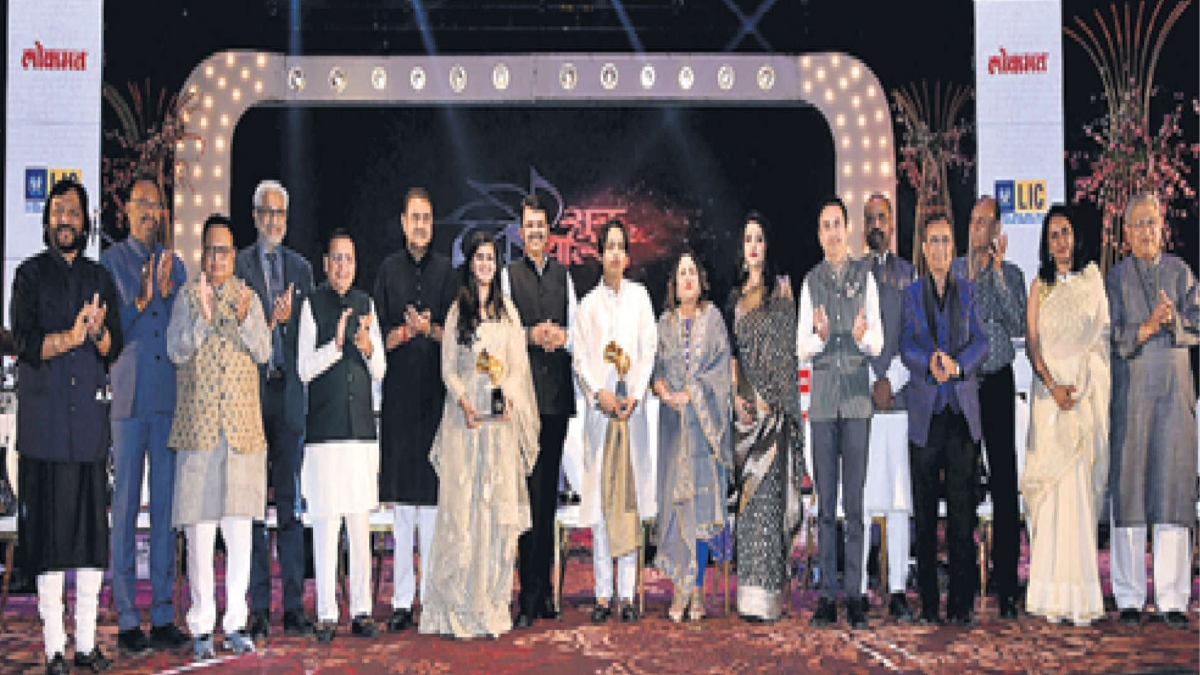INTRODUCTION
The ninth Lokmat Sur Jyotsna National Music Awards-22 were presented in a glittering function to talented singer Shalmali Sukthankar and young sitar player Mehtab Ali Niazi here at Kavivarya Suresh Bhat Auditorium on Wednesday.
The event was accompanied with a stirring musical performance by both the artistes as also by Lydian Nadhaswaram, the winner of the eighth edition of Awards. Noted Indian classical vocalist Kaushiki Chakraborty and her troupe presented mesmerising fusion music.
The presentation ceremony took place in presence of former union aviation minister Praful Patel, leader of opposition in state Assembly Devendra Fadnavis. Founder editor of The Wire Siddharth Varadarajan, Axis Bank vice-president Amruta Fadnavis, chairman of Editorial Board of Lokmat Media group and former member of Rajya Sabha Vijay Darda, Editor-in-Chief Rajendra Darda, former Union minister Hansraj Ahir, former minister MLC Chandrashekhar Bawankule, Bright Outdoor Media CMD Yogesh Lakhani, former Jalgaon mayor Rameshdada Jain, Sur Jyotsna Music Award jury members renowned singer Roop Kumar Rathod, Pandit Shashi Vyas, Gauri Yadwadkar of Times Music, Lokmat Sakhi Manch President Ashoo Darda and Lokmat Media group Managing Director Devendra Darda were prominently present on the dais.
The stage at the Kavivarya Suresh Bhat auditorium, where the award distribution function was held, was lit with colours as the eminent artistes from across India gave a vibrant performance.
Music prodigy Lydian Nadhaswaram took to stage playing Sur Jyotsna anthem on piano, a tribute to legendary late singer Lata Mangeshkar, a mesmerising piece using the loop machine and an energetic solo piece on drums.
The audience could not help but tap their feet at every beat. This year’s Sur Jyotsna award winner, Shalmali Sukthankar came up next on stage and mesmerised the audience with a brilliant performance. The audience could only say ‘once more, once more’. When Mehtab Ali Niazi took to stage with his Sitar accompanied by Ojas Adhiya (tabla) it was a calm and composed atmosphere with Mishra Khamaj playing on the instruments. Music lovers were seen nodding along.
It was then chance of the vibrant Kaushiki Chakraborty and her team S. Akash (flute), Darshan Joshi (drums), Murad Ali (Sarangi), Atul Raninga (keyboard), Sheldon DeSilva (bass guitar) and Ojas Adhiya (tabla), to take the stage by storm, and the jam-packed hall reverberated with ‘Waah! Kya baat!’
Earlier, addressing the programme, Devendra Fadnavis said that Jyotsna Darda was devoted to music and she promoted it throughout her life. Sakhi Manch has done an excellent work of empowering women. Lokmat has taken initiative in honouring Indian artistes and acknowledging their talent and skill. The earlier winners have made a name for themselves nationally. Sur Jyotsna National Music Awards is one of the most prestigious awards of the country, he added.
Praful Patel said he always attended the presentation ceremony of the Sur Jyotsna National Music Awards as it has been an excellent and memorable occasion. Lokmat selects talented artistes from all over the country and gives recognition due to them. These awards help the artistes in building a career. Patel said these awards are not only the talk of Nagpur city but of the entire country.
Chairman of Editorial Board of Lokmat Media Vijay Darda said that music is a sadhana and the person who practises it gets connected to life and humanity. The contribution of the legendary singer Lata Mangeshkar is immortal. Her death has created a void in the music world.
Darda praised Lata Mangeshkar’s brother Hridaynath Mangeshkar, who was a jury member, for his contribution and support finding out talented singers for this award. He said that Jyotsna Darda loved music. She had practised it since her childhood. The awards are an effort to fill the void created by her demise, he added.
Over the past eight years, this platform has been instrumental in inspiring many talented artists for their future endeavours in the field of music. The Lokmat Sur Jyotsna National Music Awards is a platform through which many new musicians are introduced to the country and it also contributes to the expansion of the field of music.
This award has created a distinct identity for itself in the world of music and has been instrumental in instilling a love for music in the younger generation across the country.
ABOUT THE WINNERS OF SUR JYOTSNA NATIONAL MUSIC AWARDS-2022
Shalmali Sukthankar:
Shalmali Sukthankar is a Marathi singer who shot into the limelight with her song Chandoba. She started taking lessons in music from Dr Vaijayanti Joshi at the age of five. In 2009, she was selected in the first round of Zee Marathi reality show Sa Re Ga Ma Pa, Little Champs and was one of the top six contestants. The show enriched her knowledge and awareness of singing and she was drawn to the field full time. After school, she went to Ramnarain Ruia College, Mumbai, to study art. She took singing lessons from Varsha Bhave, the one who trained her in Sa Re Ga Ma Pa. Soon after, she got her first break as a playback singer in the Marathi film ‘Hasle Mani Chandne’.
MEHTAB ALI NIAZI
Mehtab Ali Niazi was born on October 20, 1997. Mehtab is a sitar player of Bhindi Bazar family. He is the son of famous sitar player Ustad Mohsin Ali Khan, who started training Mehtab from the age of four. Mehtab has been performing ever since. Mehtab gave his first performance at the age of six at Pandit Birju Maharaj’s birthday celebration. The audience was amazed by his incomparable presentation. Today, he is known as an incredible emerging sitar player and has a reputation across the country. He has performed in various cities and his talent is being appreciated by connoisseurs of music. Mehtab has also represented India in many international concerts.


 Opinion3 years ago
Opinion3 years ago
 Entertainment8 years ago
Entertainment8 years ago
 Entertainment8 years ago
Entertainment8 years ago
 Fashion8 years ago
Fashion8 years ago
 Opinion4 years ago
Opinion4 years ago
 Entertainment8 years ago
Entertainment8 years ago
 Politics8 years ago
Politics8 years ago
 Entertainment8 years ago
Entertainment8 years ago









